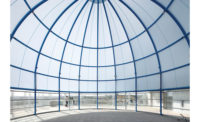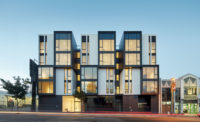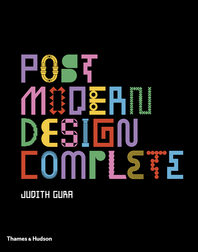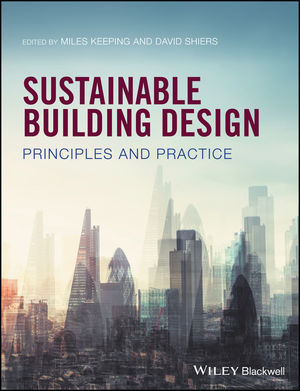Design Vanguard 2017: Ambrosi Etchegaray
Mexico City

Mezcal House
With demand for the agave liquor growing, this renovation expanded a production facility in the state of Oaxaca to provide more space while following a traditional layout. An oven occupies the center of the building, while adjacent areas are separated by concreteframed walls made with rammed earth from the site.
Photo © Onnis Luque

Culture Fair Pavilion
This 8,450-square-foot temporary structure was designed for Mexico City’s annual international cultural fair to create a marketplace-like atmosphere in the city’s historic center. The aluminum structure supported scaffolding and tarps; burlap sacks hung around the inner and outer circumferences were a nod to the role of trade and commerce.
Photo © Rafael Gamo

Children’s Museum Chapultepec
Providing new outdoor exhibition spaces in Mexico City’s Chapultepec Park, the exterior component of this museum expansion creates five distinct landscapes mimicking various environments in the Valley of Mexico. The spaces seek to touch the ground lightly by employing permeable gravel surfaces and elevated walkways.
Photo © Jaime Navarro

IT Building
Situated in Mexico City’s Condesa neighborhood, this six-unit residential building is constructed of stacked concrete slabs. A grid-like front facade is punctuated by terraces filled with greenery to create a buffer between the apartments and the city.
Photo © Rory Gardiner




Architects & Firms
When a 7.1-magnitude earthquake shook Mexico City on September 19, architects at the office of Ambrosi Etchegaray were already working as part of a multidisciplinary team helping to rebuild the Unión Hidalgo community, one of the areas along Mexico’s southern Pacific coast most affected by an 8.1-magnitude quake earlier that month. The studio, which is located in Condesa, a stylish Mexico City neighborhood that was one of the hardest hit by the second quake, is now working with several institutions on plans for repairing significant historic buildings throughout the capital as well.

"We were busy, but you find the time,” says Gabriela Etchegaray, 33, who, with Jorge Ambrosi, 40, founded the studio in 2011. Even with more work, Ambrosi and Etchegaray prefer to have fewer than a dozen staff, allowing the office to be nimble and collaborative. A steady stream of residential projects, largely led by Ambrosi, make it financially possible for the team to take on smaller-scale work that explores different programs and materials.
Making use of locally available resources has been a constant in the studio’s work. At the Casa Wabi Foundation, a nonprofit established by Mexican artist Bosco Sodi to support young artists, the team is designing a nursery to cultivate the nearly extinct Guayacan tree. The plan involves an excavated walkway that allows workers to stand upright while caring for seedlings. Nearby, they are also designing a small house composed of three pavilions and a pool. The site was piled with burned brick used by Sodi in the production of his large-scale ceramic works, so the architects found a way to incorporate the discarded materials, along with red concrete, into the house’s structural elements.
For a Grupo Habita hotel in downtown Mexico City, the studio is adapting a colonial structure at the back of the Metropolitan Cathedral, adding patios to each room. “It’s like a puzzle,” says Etchegaray. Another puzzle is the project’s fast timeline (projects in Mexico often operate at a breakneck speed that forces design and construction phases to overlap). “Every week, we have to take plans to the site in order for the construction team to work,” says the architect. “We have less time to think and experiment with ideas, but it’s always good to have different processes; you need to be pragmatic.”
Mixed with that pragmatism is an attention to local culture and heritage—for now, in Mexico, and, hopefully, in the future, beyond. “I fantasize about building projects in different countries, to prove ourselves in different conditions, with different human resources and materials, and see what results,” says Etchegaray. Even as the team aims for more international work, including its design for the Mexican Pavilion at the 2018 Venice Biennale, it is steadfastly connected to the local community, both professionally and personally. The studio recently took in another architecture office whose space was destroyed in the earthquake, and, along with about 20 other nearby studios, they play soccer in a league organized by Tatiana Bilbao. And as sometimes seems inevitable in the architecture world, Ambrosi and Etchegaray became partners outside of the office after they started working together. If they weren’t sharing a studio, they might have to choose between family life and office life, between community and international recognition. But like many successful couples, for now they find a way to have both.
Ambrosi Etchegaray
FOUNDED: 2011
DESIGN STAFF: 8-12
PRINCIPALS: Michael Young, Kutan Ayata
EDUCATION: Ambrosi: National University of Mexico, B.Arch., 2008. Etchegaray: Columbia University GSAPP, M.S. Critical, Curatorial, and Conceptual Practices in Arch., 2018; Universitat Politècnica de Catalunya and Iberoamericana University, M.S. Creative Management and Transformation of the City, 2012; Universidad Iberoamericana, B.Arch., 2008
WORK HISTORY: Ambrosi: Fabric (founding partner), 2003–08; JSª (formerly Higuera + Sanchez), 1999-2003. Etchegaray: Collaborations with Rojkind Arquitectos, Isaac Broid, Esrawe Studio, 2006–11; TALLER|Mauricio Rocha + Gabriela Carrillo, 2008–10
KEY COMPLETED PROJECTS: Tamosura Park, Cananea, 2017; Children’s Museum Chapultepec, Mexico City, 2016; IT Building, Mexico City, 2016; Fair for Culture Friends, Mexico City, 2016; Milagrito Mezcal Pavilion, Santiago de Matatlan, 2015; Nacozari Square, Nacozari de García, 2014; AS Town Houses, Mexico City, 2014 (all in Mexico)
KEY CURRENT PROJECTS: Mexican Pavilion for the International Architecture Exhibition at the 2018 La Biennale di Venezia, Venice; Grupo Habita Hotel, Mexico City; Guayacan Pavilion, Puerto Escondido, Mexico










